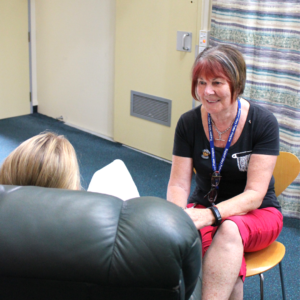In 38 years of nursing at Mary Potter Hospice, Di has seen many people die. “It’s part of life; we’ve all got to do it,” she says. But some cases make her feel particularly sad. “I guess the younger people, which doesn’t seem fair – like parents losing their children.”

She remembers the pleading of a child who suddenly realised what the loss of a father was going to mean. That time, Di had to leave the room. Di, 71, is the longest serving member of staff at Mary Potter Hospice. She trained in Wellington Public Hospital and worked in theatre, orthopaedics and district nursing. She was employed by the Sisters of the Little Company of Mary in March 1981. Her children were young, and she was looking for evening shifts. “The hours suited both them and me because I would come on and relieve the nuns because they would go to mass at 6 o’clock,” she says.
“You could buy your own uniform – different colours, different styles. In the mid-to-late ’80s they got rid of the uniforms,” she says. “I think it’s nicer for the patients.”
“When I was training, I was terrified of death. By the age of 18 I was on a medical ward, and on by myself at night.” She says she would wait outside a door and listen for breathing, rather than go into a room where she thought someone might have died. “And then to go down the palliative care track – and to think what I was like.”
Di recalls that treatment was more basic back in those days. “I think we had morphine injections. The equivalent to a morphine pump would have been an intravenous drip with some morphine in the bag.” Cancerous tumours would develop into wounds and Di remembers adding sweet-smelling oils to the dressings. “There are seldom any tumours that erode through the skin now.”
She says the huge difference in hospice care is the medication that is now available, along with palliative chemotherapy and radiotherapy to control the symptoms and the cancers themselves. “We have come a long way with pain relief and how we can control symptoms.”
In 1984, her father was admitted to Mary Potter Hospice and she then learned what it was like to be the family of a patient. She continued working while her colleagues cared for him. “I knew he was being well looked after. He was 67, younger than I am now.”
